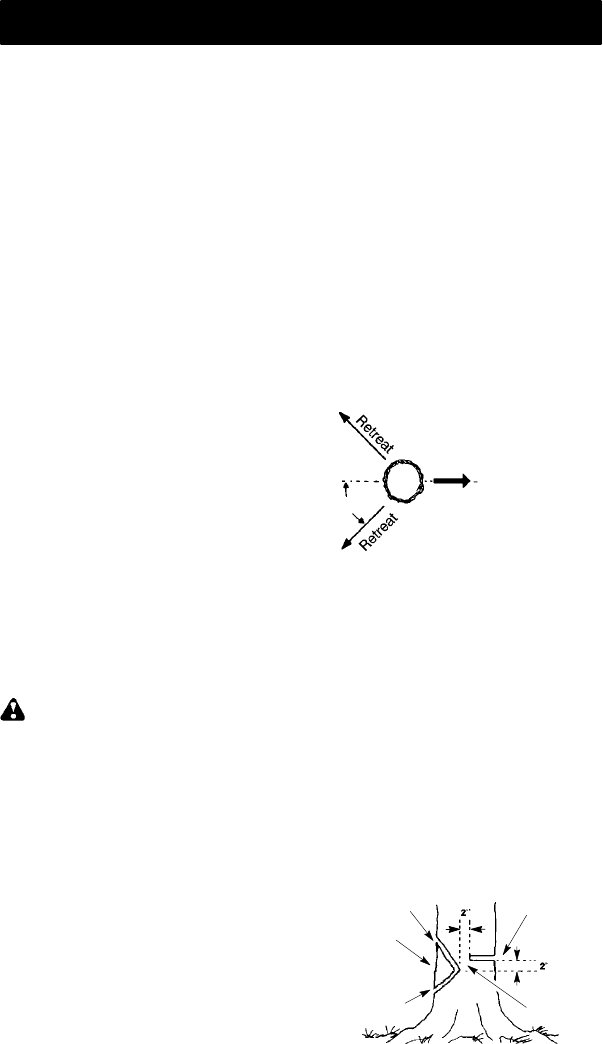
9
CUTTING METHODS
OPERATING TIPS
S Check chain tension before first use
and after 1 minute of operation. See
CHECKCHAIN TENSION in the MAINTE-
NANCE
section.
S Cut wood only. D o not cu t me tal , plas-
ti cs, masonry, non-wood buil di ng mate-
rial s, et c.
S Stop th e saw if the chai n strike s a f o r-
eign object. Inspect t he saw and repai r
parts as necessary.
S Keep t h e cha in out of dir t and sand.
Even a small amount of dirt wi l l quickly
dull a chain and increase the possibility
of kickback.
S Pra ct ice cutt ing a few small log s using
the following steps. This willhelp youget
the “feel ” of usi ng your saw befor e you
begin a major sawing operat i on.
S Squeeze trigger swi tch and allow unit
to reach ful l speed before cutting.
S Begin cutting with the saw frame
against the log.
S Keep the motor at full speed the en-
tire time you are cutting.
S Release the trigger switch as soon
as the cut is completed, allowing the
motor to stop.
S Keep the cord a way fr om the cutt ing
area . Posit ion cord so it wil l not be
caught on branches and t he like dur-
ing cutting.
S To avoid losing control when cut is
complete, do not put pressure on
saw at end of cut.
S St op moto r befor e setti ng saw down.
TREE FELLING TECHNIQUES
WARNING: Check for broken or
dead branches which can fall while cut-
ting causing serious injury. Do not cut
near buildings or e lectrical wires if you
do not know the direction of tree fall, nor
cut at night since you will not be able to
see well, nor during bad weather such
as rain, snow,or strong winds,etc. Ifthe
tree does make contact with any utility
line, the utility company should be noti-
fied immediately.
S Careful l y plan your sawing operat ion in
advance.
S Clear the work a r ea. You need a c l ear
area al laround the t r ee so you can have
secur e footing .
S The chain saw operator should k eep
on the uph ill side of the terrain as the
tree is likely to roll or slide downhill af-
ter it is felled.
S Study the natural condit i ons that can
cause the tree to fall in a particular direc-
tion, such as:
S The wind direction and speed.
S The lean of the tree. The l e anof a tree
mi gh t not be apparent due t o uneve n
or sloping terrain. Use a plumb or level
to determine the dir ecti on of tree lea n.
S Weight and branches on one side.
S Surrounding trees and ob stacles.
S Look for decay and rot. If the trunk is
rotted, it can snap and fall toward the
operator.
S Make sure there is enough room for
the tree to fall. Maintain a distance of
2-1/2 treelengths fromthe nearestper-
son or other objects. Noise can drown
out a warning call.
S Remove dirt, stones,loose bark,nails,
staples, and wire from the tree where
cuts are to be made.
Direction of Fall
45_
Plan a clear retreat path
FELLING LARGE TREES
(6 inches in diameter or l ar ger)
The notch method is used t o f ell lar ge
trees. A notch is cut on th e side of the tre e
in the desired direction of fall. After a felling
cutismadeontheoppositesideoftree,
the t ree will tend to fall in the direction of
the notch.
NOTE: If tree has large buttress roots,
removethembeforemaking thenotch.If
using saw to remove buttress roots,
keep saw chain from contacting ground
to prevent du lling of the chain.
NOTCH CUT AND FELLING TREE
S Make notch cut by cutt i ng the top of the
notc h fi rst . Cut thr oug h
1/3 of the
diameter of the t r ee. Next complete the
notch by cutting the bottom. See illustra-
tion. Once the notch is cut, remove the
wedgeofwoodfromtree.
Notch
First cut
Second cut
Final cut here
Hinge


















